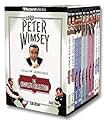There are several ways for a writer to startle the reader at the end of a mystery. The most overused is "the least likely suspect" solution, a variant being found in an early Ellery Queen novel when a character already proven to be innocent turned out to be the guilty party. Agatha Christie broke all the rules when she made the first-person narrator the killer and again when she made all the suspects the collaborating killers and most outrageously of all when she made the Master Detective the killer. (Contact me if you want the titles of these books.) With Dorothy Sayers we have far better written novels--though not necessarily better mysteries than those solved by Poirot and Marple--with characters far more human and therefore interesting. So when the BBC decided back in 1972 to film several of her Lord Peter Wimsey mysteries, mostly at the urging of comedian Ian Carmichael, that actor was not even on the short list of candidates for the part since he was too closely associated with Bertie Wooster, whom he had shortly before that played on British telly. But he got the part and the rest is history. Five of the Wimsey mysteries were filmed and shown a year later on "Masterpiece Theatre": Clouds of Witness, The Unpleasantness at the Bellona Club, Five Red Herrings, Murder Must Advertise and The Nine Tailors. They were a smash with audiences on both sides of the Atlantic and showed up later with a new series title, "Murder Most British," which included only three of them. The Lord Peter Wimsey website was filled with inquiries from fans panting to get copies of any or all of the fabulous five, but the BBC retained a stony silence. The good news is, as you might have guessed by now, that Acorn Media is releasing four of them and <Clouds of Witness> is now available as a boxed set of five tapes and it is a stunner. My only quibble is that more than one of the 45 minute episodes could easily have been accommodated on a tape; but I am so delighted to have it at all that any such monetary objections must fall by the wayside. Without revealing the ending, let me say it is of a type not already mentioned in my opening! Lord Peter's brother Gerald is accused of murdering a man he had just argued with that evening and steadfastly refuses to say where he was at the time of the killing, although he was found bending over the body and his own gun was the means of death. So with too many clues to help him and a certain major character making up lies all the way, Lord Peter is chased by a vicious dog, nearly drowns in a bog, barely makes a stormy trans-Atlantic flight to save his brother, and unlike the more cerebral Poirot, bumbles now and then in his conclusions in a very human way. In fact, all the characters are quite human. When the well-read Wimsey tosses a reference to "Manon Lescaut" to his Scotland Yard companion and brother-in-law-to-be (played beautifully by Mark Eden), the impatient detective retorts, "I never read Manon Lescaut," and drawing an apology from the somewhat abashed Lord. Even the Duchess avoids stereotype with her upperclass-cool remarks concerning the proceedings, suggesting in a deep contralto a "nice cup of tea" at a crisis during her son's trial. As with the BBC Poirot series, the 1920s décor is impeccable and adds greatly to the amusement. Indeed it is for the acting and the art design that I will return many times to view this and the other tapes. I can only hope that The Nine Tailors will find its way into the series once the other four are out for sale. Acorn Media, who has already given us "Mapp and Lucia," "Disraeli," and the Canadian Gilbert and Sullivans already reviewed on these pages, is to be thanked for making this new series available to seekers of the finer style of mystery recreation.


































